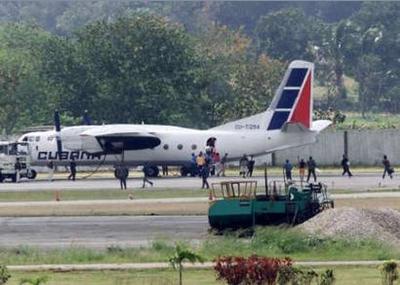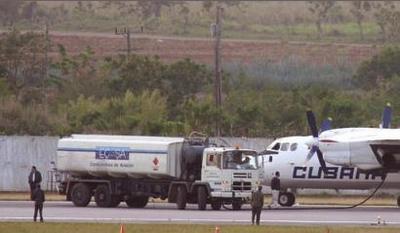AN-24 Lands Safely In Florida, Hijacker In Custody
 It's over. Twelve hours of tension, negotiations,
false hope and, finally, freedom. It began when a passenger,
carrying a small boy, threatened to use two hand grenades to
destroy a Cubana Airlines AN-24 with 33 passengers on board. It
ended Tuesday when the plane was allowed to take off from Havana
and land in Key West (FL).
It's over. Twelve hours of tension, negotiations,
false hope and, finally, freedom. It began when a passenger,
carrying a small boy, threatened to use two hand grenades to
destroy a Cubana Airlines AN-24 with 33 passengers on board. It
ended Tuesday when the plane was allowed to take off from Havana
and land in Key West (FL).
The hijacking was the second in two weeks of a Cuban airliner by
Cubans seeking to leave their communist-run island for the United
States.
The suspect forced the plane to leave Cuba despite a stern
warning from the top US diplomat in Cuba. The State Department said
James Cason delivered the warning from the Havana airport control
tower after Havana asked Washington to tell the man he faced U.S.
prosecution if he flew to the United States.
In Key West, FBI agents surrounded the Cubana Airlines twin-prop
Antonov 24 as police aimed guns at the aircraft.

What Was The Count Again?
After initially reporting 31 people were on the plane, U.S.
authorities said 33 got off -- 25 passengers, seven crew and the
suspect. Many emerged with their hands in the air and lay on the
tarmac.
Among them was the suspected hijacker, wearing a red jacket with
"America" stitched on it. He carried a small boy to the bottom of
the aircraft's stairs before being taken into custody, Key West
police spokesman Steve Torrence said.
US authorities said the 33-year-old suspect apparently had
his wife and 3-year-old boy with him on the plane.
Sheriff's deputies removed what appeared to be two hand grenades
from the suspect's pockets, Torrence said.
"We don't know whether he in fact had grenades," Miami US
Attorney Marcos Daniel Jimenez said, adding the objects were being
examined. "They may have been false or inoperable objects that
appeared to be grenades."
Cuban authorities said the suspect, Adelmis Wilson, had a
criminal record and that police found handmade grenades at his home
on the Isle of Youth, an island off mainland Cuba.
The other passengers and crew were being held by US
authorities for questioning.
Cuba said the plane was hijacked on a flight from the Isle of
Youth to Havana. The hijacker threatened to explode a grenade
unless he was flown across the Florida Straits, but the plane did
not have enough fuel. Disobeying the hijacker's orders, the pilot
landed at Havana's international airport.

12-Hour Standoff
After a 12-hour standoff that closed Havana airport, the
hijacker allowed nearly two dozen passengers to leave the plane. It
was refueled and took off for Key West.
The North American Aerospace Defense Command scrambled two F-16
fighter jets, which intercepted the plane halfway through the
90-mile journey and escorted it to Key West.
The hijacking came less than two weeks after six Cubans hijacked
a DC-3 at knifepoint with 31 other people on board and forced the
pilot to fly to Key West.
The Blame Game
Havana, Washington's longtime ideological foe, says the United
States encourages Cubans to leave the island illegally with its
policy of granting residence in the United States if they make it
to land.
"Cubans leave Cuba illegally because of the repressive and
unrepresentative political system and the anachronistic and
inefficient economic system the Cuban government maintains," State
Department spokesman Chip Barclay said.
The six charged with hijacking the DC-3 in March sought asylum
in the United States but instead were arrested and charged with air
piracy. Most of the crew and passengers were returned to Cuba but
some chose to stay in the United States.
 NTSB Final Report: Cozy Cub
NTSB Final Report: Cozy Cub ANN FAQ: Contributing To Aero-TV
ANN FAQ: Contributing To Aero-TV Classic Aero-TV: Seated On The Edge Of Forever -- A PPC's Bird's Eye View
Classic Aero-TV: Seated On The Edge Of Forever -- A PPC's Bird's Eye View ANN's Daily Aero-Linx (04.29.25)
ANN's Daily Aero-Linx (04.29.25) ANN's Daily Aero-Term (04.29.25): Execute Missed Approach
ANN's Daily Aero-Term (04.29.25): Execute Missed Approach





